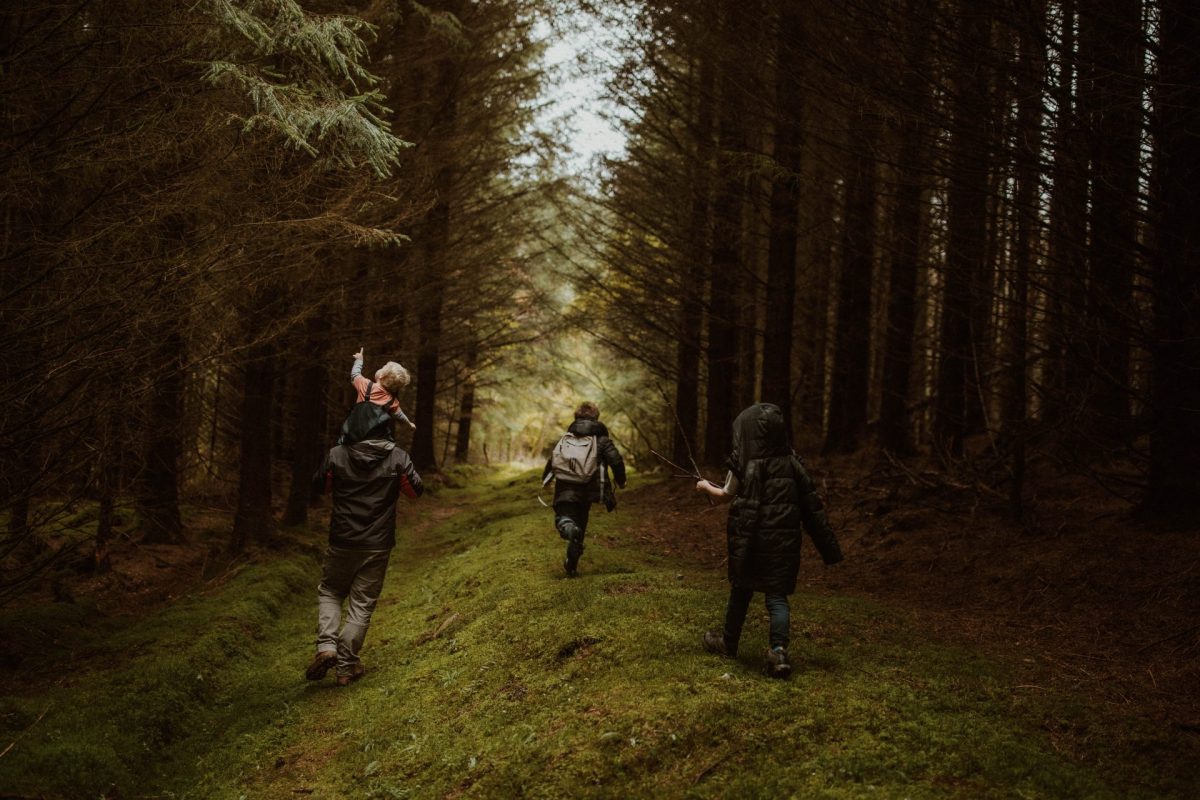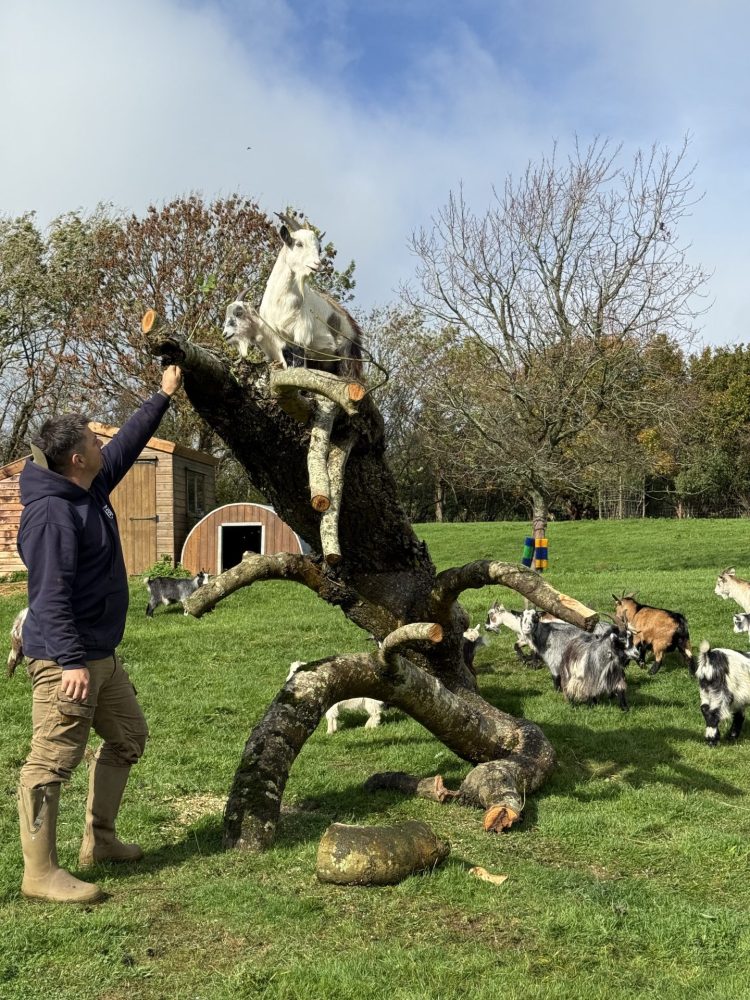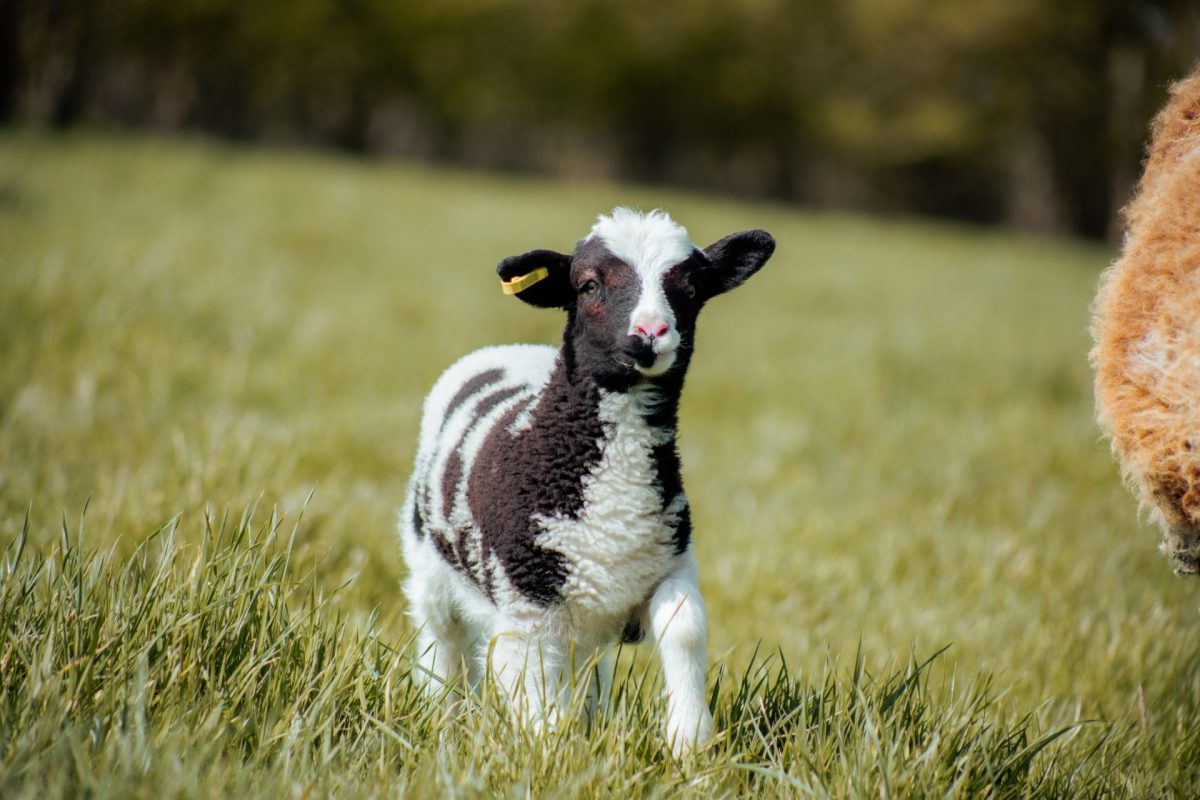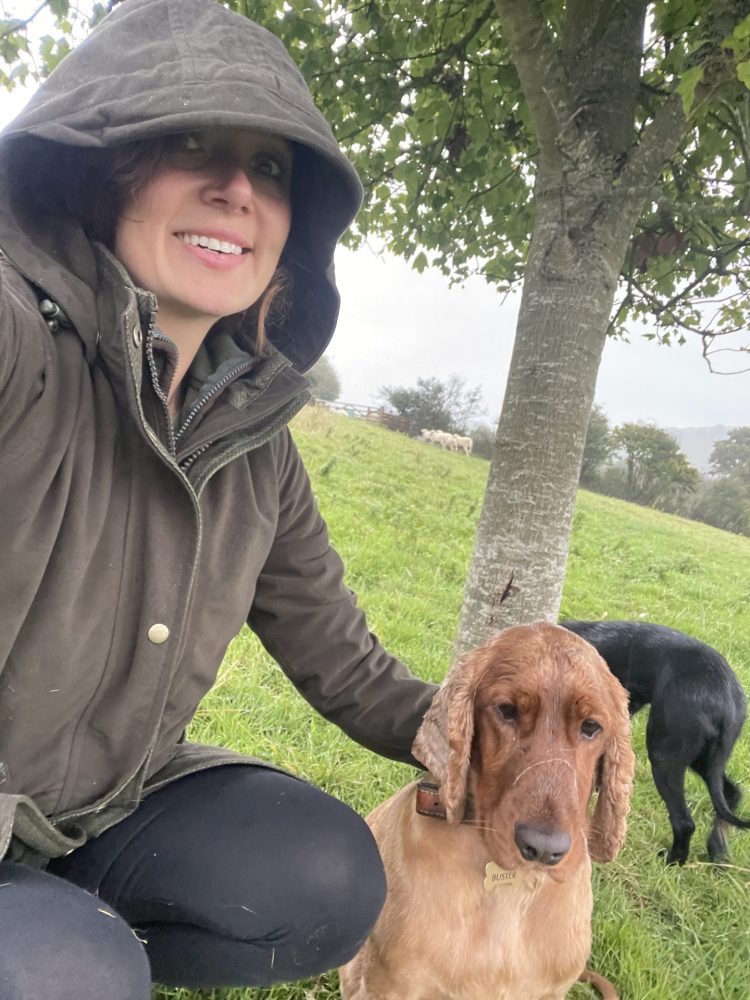Autumn at Rudge Farm: When the Cottages Calm and the Land Comes Alive
When the bustle of summer holidays fades and the cottages quieten, the fields and woodlands at Rudge Farm take on a golden glow. Most people think of autumn as the time to hunker down indoors — but for us, it’s quite the opposite.
As much as we’d love to be curled up by the fire with a mug in hand, autumn is when the real work begins. The leaves are falling, the air turns crisp, and Lady Rudge and Lord Rudge swap their cosy slippers for wellies and head outdoors — often in the drizzle, sometimes in the mud — with Jason’s much-loved digger rumbling happily in the background.
This season, our regenerative projects have been in full swing. From logs to kestrels, goats to brambles, here’s what we’ve been up to in our autumn of wilding and wonder.
1. Log Piles, Fallen Trees & Cosy Bug Havens
One of our big autumn projects has been logs — simple, honest, essential.
We only ever process trees that have already fallen in storms or ones our tree-surgeon has agreed are at the end of their natural life. Those logs then serve two purposes: some are dried and used as firewood for the farmhouse, and others are left in the woodland to nurture life.
We scatter selected logs in sheltered spots throughout the woodland — only in autumn — to act as natural habitats for beetles, fungi, woodlice and countless other tiny woodland residents. It’s not a “bug hotel” exactly, but it does the same job: offering a home for insects to thrive, helping them break down the wood, recycle nutrients and create rich soil, all without invading our growing or freshly planted trees.
It’s muddy, sometimes slippery, and always a bit of a family affair — everyone joins in, stacking logs, hauling branches and sharing laughs as Jason manoeuvres his digger through the trees. But the result? A living, breathing woodland that gives back year after year.

2. The Kestrel Box – Nature’s Feathered Pest Patrol
This autumn we also installed a brand-new kestrel box high above the middle livestock field. It’s perfectly positioned, with sweeping views across the meadows — and hopefully, a five-star location for a kestrel looking for a new home.
The idea is simple: we love our livestock, but they attract a few unwelcome visitors. Mice and voles have been known to sneak into the Pygmy Village (our goat accommodation), much to everyone’s frustration. Enter the kestrel — graceful, focused, and an excellent natural form of pest control.
According to conservation groups like the Game & Wildlife Conservation Trust and the Woodland Trust, kestrels play a key role in British farmland ecology. They help maintain balance by hunting small mammals, reducing pest populations naturally. Kestrels have also suffered habitat loss in the UK, so providing safe nesting boxes can directly help their recovery.
We’ve already been lucky enough to have a resident peregrine falcon who seems to have adopted Rudge Farm as its home — spending most of its days perched between the football pitch and the livestock field. Watching it swoop and hover in the morning light is pure magic. Between the falcon and the kestrel box, our pest problem has become a wildlife win-win: fewer mice, more birds of prey, and one very happy Lady Rudge.
Link to our Kestrel box below.
3. A Goat Play Area – Nature-Made, Not Man-Made
Another highlight of this autumn has been the goats’ new playground. When a large tree came down in a recent storm, we decided to embrace nature’s design skills.
Jason, digger at the ready, carefully moved the huge trunk to the middle meadow — where it now sits proudly as a climbing paradise for Peter and Penelope (our resident goat royalty).
We call it “Pride Rock” — because watching Peter at the top, surveying his leafy kingdom, feels straight out of The Lion King. Guests love seeing the goats clambering up the trunk, striking poses, and generally being their cheeky, curious selves.
It’s eco-friendly, cost-free, and regenerative in spirit — turning a fallen tree into enrichment for our animals. No plastic, no carpentry, just pure nature doing what it does best.

4. Tackling the Brambles – Reclaiming the Woodland
When we first bought the 20 acres that make up Rudge Farm — cottages, woodland and fields — some areas were so overrun with brambles (or “brown bulls”, as they’re known locally) that you could hardly walk a metre without snagging your jumper.
Now, brambles are brilliant for birds, deer and insects — they provide shelter and food — but they can also choke out paths, young trees and entire sections of woodland. This autumn, Jason ( in his trusty digger) has been tackling one of the last dense patches: around an acre of solid bramble thicket.
The goal isn’t to remove them entirely — far from it — but to make them manageable. We’ve thinned and reshaped them into accessible clumps so that wildlife still has cover, but we can also reach the areas we need to maintain. And, crucially, we can now get to the berries.
Blackberry-picking is a family ritual here at Rudge Farm — buckets, scratches, purple fingers and all. The jam we make from it never makes it to the farm shop because it’s gone long before. A jar rarely lasts a week in the Watkins household, showing up at breakfast, lunch and (sometimes) dinner.
It’s not glamorous work, but it’s rewarding — and it keeps our woodlands healthy, accessible and alive.
5. Damming the Brook – A Family Favourite
Running through Rudge Farm is a beautiful brook that winds its way between fields and woodland. It’s a gem — but when the rains come, it can turn wild. Fast-flowing water erodes banks, shifts soil and can damage the delicate habitats along its edge.
Our solution? A bit of good old-fashioned damming.
We periodically build small, natural dams to slow the flow, raise water levels slightly, and protect the banks. It’s not just practical — it’s a family competition. Every autumn weekend, the mini-Rudgelings don their waders, grab sticks and mud, and spend hours building dams, debating strategy, and boasting about “structural integrity”.
Then, after the next big rainfall, we inspect the results. Whoever’s dam survives the storm wins. (Lady Rudge has lost points many times — usually due to an errant log floating down-stream, not her engineering skills, she insists.)
It’s messy, it’s fun, and it teaches respect for the land and water. Better still, the small pools that form behind the dams attract frogs, insects, and birds — proof that even play can be regenerative.

6. Mulching Magic – Turning Waste Into Gold
Another thing we’ve been tackling this autumn is mulching — the final, satisfying step in our regenerative loop.
We chip our own trees from one season to the next, turning wood into fine, fragrant chippings. Those chippings head straight into the aviaries, where the chickens do their bit. They scratch through it, mix it with straw and, well… a generous helping of chicken poop. Over time, it all breaks down together into one glorious, rich mulch.
Once ready, we shovel it out, load it into wheelbarrows, and spread it around the planting areas and woodland sanctuaryacross the farm. The result is stunning — dark, crumbly, and full of life.
This mulch does double duty: it protects young seedlings from frost through the colder months, and it nourishes new growth come spring thanks to the natural fertilisation from the chickens. It’s a simple, sustainable cycle — one that keeps our soil fertile, our plants happy, and our landscape looking beautifully cared for.
And yes — it smells like hard work, but looks like perfection.
7. Woolly Wonders – Nature’s Own Protection
Just after shearing our sheep this year — a few weeks later than usual, as autumn began to roll in — we found another use for the flock’s glorious fleece.
At Rudge Farm, sheep’s wool isn’t just soft and beautiful; it’s an incredible natural resource. We use it in two clever ways: to deter slugs and snails in spring and to protect our plants from frost in winter.
You might have wondered where all the slugs and snails disappear to once the cold weather arrives. They don’t vanish off to Spain — they simply hide away, waiting to reappear and munch through your hostas the moment spring returns! By wrapping the base of our smaller plants and seedlings with wool in autumn, we create a natural, breathable barrier that helps trap warmth and moisture while discouraging unwanted nibblers.
Then, when the flock is sheared again in spring, we reuse the fresh wool to circle our garden beds and protect tender new shoots from slugs and snails — all without a single drop of chemical pesticide.
It’s completely free, completely natural, and completely brilliant. The sheep grow it, we recycle it, and the plants thrive — a perfect regenerative circle of woolly wonder.
And if you’re feeling inspired, why not get in contact with your local sheep farmer and ask if you could buy a bag of wool in autumn or spring? Most farmers have plenty left over — it’s sadly no longer a big money-making scheme — and many would be more than happy to sell a bag or two locally. It’s a wonderful way to support your local farming community and give your garden some sustainable, homegrown protection at the same time.

Regeneration in Real Life
When you add it all up — the logs, the kestrel box, the goat playground, the bramble work, the brook dams, the mulch, and the wool — it’s a whole landscape coming back to life through small, thoughtful actions.
This is what we mean by regenerative living. It’s not just big gestures or fancy systems. It’s about balance — giving back as much as you take, working with nature rather than against it, and seeing opportunity in every challenge (even a fallen tree, a muddy brook, or a pile of fleece).
It’s also about family, community and joy. These projects take hours — muddy, messy hours — but they bring laughter, learning and connection. And when we finally do light that fire in the evening, we know the warmth comes from logs we collected ourselves, from a land that’s thriving.
Come See the Wild Side of Rudge Farm
If you visit Rudge Farm this season, you’ll see the signs of it all — the log piles tucked into woodland corners, the kestrel box perched high above the fields, Peter and Penelope on their “Pride Rock”, the glistening mulch around the plants, tufts of wool around the beds, and the gentle trickle of our dammed brook.
It’s not manicured. It’s not perfect. It’s alive.
Autumn might bring golden leaves and misty mornings, but for us it’s also a time of muddy boots, laughter, and regeneration in action. And we wouldn’t have it any other way.





